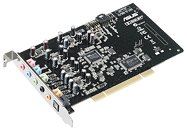Friday, October 26th 2012

ASUS Unveils the Xonar D-KARA Audio Card
As the online karaoke and recording phenomenon continues to gain traction, demand has emerged for dedicated hardware that enables pro-level singing and recording via PC at home. The ASUS Xonar D-KARA karaoke audio card (PCI interface) presents professional effects and recording capabilities, designed by Xonar and music industry engineers. It supports simplified pre-set recording and extra-detailed input, with strong hardware that ensures optimized voice syncing and ultra-vivid 106dB SNR.
D-KARA helps customers enjoy social singing, recording, editing, and sharing of vocal performances, consolidating features under the user-friendly Xonar Audio Center.Online karaoke a global trend
Internet-based communal singing and karaoke-style experiences have seen tremendous growth recently. Supported by numerous services and sites (including YouTube), online karaoke is becoming more popular due to its social entertainment value. Like-minded people with a fondness for singing get together, friends and family gather for enjoyable singing sessions, and would-be performers hone their skills on the way to possible superstardom. Accommodating this, the Xonar team carried out research that shows over 100,000 people engage in daily online karaoke across Eurozone markets, while in mainland China the customer base stands at an amazing 500,000 singers per day. The team also received feedback showing that customers are interested in karaoke-specific hardware to improve their experiences, as software-based karaoke sites and services often offer basic features, suffer from latency, and lack proper recording facilities. Xonar D-KARA corrects these shortcomings in direct response to community input.
Everyone becomes a pro performer with D-KARA
The Xonar team packed an entire album of features in the design. Studio-level vocal effects include high-pass filtering, low-pass filtering, compression, dynamic boost, voice equalization, and reverb. All work hardware-level so greater fidelity is guaranteed, while customers can tune vocal masterpieces as they see fit, with enough enhancements to make virtually anyone a singing idol. Other highlights are built-in key shifting and vocal cancellation, further helping with playback editing. Precise stereo mixing and recording mean users simply plug a microphone into D-KARA and get started on their own song portfolio, which can then be shared online or via physical storage. To make settings quicker, D-KARA offers five one-click selectable master presets defined by Xonar and studio engineers: rock, rock pro, ballad, ballad pro, and special. The pro settings cater to those looking for that stadium-filling effect, while the special preset supports a more flexible vocal range. Customers who opt to sing their own way are bound to appreciate the extensive list of advanced settings offered.
Hardware-boosted singing sensations
While software karaoke and recording products frequently force vocalists to endure latency and lag, D-KARA hardware includes an advanced microphone-input digital signal processor that exceeds onboard audio responsiveness by up to 100 times, and competing karaoke cards by as much as ten times. It elevates voice syncing to studio-grade performance, resulting in more rewarding and confidence-boosting experiences. D-KARA builds on award-winning Xonar hardware design to ensure ear-dazzling crystal clear performance, equipped with exclusive ASUS Hyper Grounding technology to increase clarity by 16 times compared to onboard audio, and leading to an impressive 106dB SNR that tops the average 90dB of integrated sound.
Natural vocal intuition
While having karaoke and recording-dedicated hardware is a strong benefit, customers need an accessible interface to fully utilize it. D-KARA employs the Xonar Audio Center, where singing and online sharing are chart toppers, so every control and feature are extra-easy to use. D-KARA therefore differs from the more complicated and often unappealing interfaces of software-based karaoke, and allows anyone with a microphone to truly enjoy personalized singing experiences.
D-KARA helps customers enjoy social singing, recording, editing, and sharing of vocal performances, consolidating features under the user-friendly Xonar Audio Center.Online karaoke a global trend
Internet-based communal singing and karaoke-style experiences have seen tremendous growth recently. Supported by numerous services and sites (including YouTube), online karaoke is becoming more popular due to its social entertainment value. Like-minded people with a fondness for singing get together, friends and family gather for enjoyable singing sessions, and would-be performers hone their skills on the way to possible superstardom. Accommodating this, the Xonar team carried out research that shows over 100,000 people engage in daily online karaoke across Eurozone markets, while in mainland China the customer base stands at an amazing 500,000 singers per day. The team also received feedback showing that customers are interested in karaoke-specific hardware to improve their experiences, as software-based karaoke sites and services often offer basic features, suffer from latency, and lack proper recording facilities. Xonar D-KARA corrects these shortcomings in direct response to community input.
Everyone becomes a pro performer with D-KARA
The Xonar team packed an entire album of features in the design. Studio-level vocal effects include high-pass filtering, low-pass filtering, compression, dynamic boost, voice equalization, and reverb. All work hardware-level so greater fidelity is guaranteed, while customers can tune vocal masterpieces as they see fit, with enough enhancements to make virtually anyone a singing idol. Other highlights are built-in key shifting and vocal cancellation, further helping with playback editing. Precise stereo mixing and recording mean users simply plug a microphone into D-KARA and get started on their own song portfolio, which can then be shared online or via physical storage. To make settings quicker, D-KARA offers five one-click selectable master presets defined by Xonar and studio engineers: rock, rock pro, ballad, ballad pro, and special. The pro settings cater to those looking for that stadium-filling effect, while the special preset supports a more flexible vocal range. Customers who opt to sing their own way are bound to appreciate the extensive list of advanced settings offered.
Hardware-boosted singing sensations
While software karaoke and recording products frequently force vocalists to endure latency and lag, D-KARA hardware includes an advanced microphone-input digital signal processor that exceeds onboard audio responsiveness by up to 100 times, and competing karaoke cards by as much as ten times. It elevates voice syncing to studio-grade performance, resulting in more rewarding and confidence-boosting experiences. D-KARA builds on award-winning Xonar hardware design to ensure ear-dazzling crystal clear performance, equipped with exclusive ASUS Hyper Grounding technology to increase clarity by 16 times compared to onboard audio, and leading to an impressive 106dB SNR that tops the average 90dB of integrated sound.
Natural vocal intuition
While having karaoke and recording-dedicated hardware is a strong benefit, customers need an accessible interface to fully utilize it. D-KARA employs the Xonar Audio Center, where singing and online sharing are chart toppers, so every control and feature are extra-easy to use. D-KARA therefore differs from the more complicated and often unappealing interfaces of software-based karaoke, and allows anyone with a microphone to truly enjoy personalized singing experiences.

16 Comments on ASUS Unveils the Xonar D-KARA Audio Card
why d-kara?
In Japanese it sounds like because... ? Funny...
*CMI audio chips pack DAC/ADC of their own, but you can design a card to use external DAC and ADC chips. Take Auzentech X-Meridean series for example, it uses CMI8788 as merely a host, it's the wonderful external DACs that do the bull-work.
I guess I should tell him about this card :rockout:
PCIE sound cards kind of cheat still and still uses a translator chip to PCI inside the chip... it brings up latency thats for sound processing brings inevitable evil...
A proper pci-e host will cost money! And the drivers also will be pain to write from scratch... also a lot of money in labor salaries... you got the idea...
Why drivers from Asus and Creative come so freaking slow...
The reasoning behind my post was, that PCI is called "legacy" for a reason. It was replaced because it couldn't catch with its parallel 8-bit data transfer to the newer faster CPUs. That's why PCIe - uses serial data transfer. And I can't wait for the older standard to be retired from use. I don't see a point for motherboard manifacturers to put these on the MBs :) in this train of thought: who has legacy PCI slots in their new MB- I don't :D
This Xonar D-KARA is an ok sound card by the way.
this reason as stated is why i don't give 2 sh!tz about upgrading from my onboard audio... its not gonna make it absolutely amazing anyway so i won't bother
CA20K2 Datasheet
And the internal BUS interface.
What in hell VCI is
So if you look on the sheet... VCI mimics a lot of PCI like system principles and I can even bet that it can work like that using old like PCI data frames. The PCI-E bridge is just taken inside the SOIC itself but on bus level same topology remained.
I cannot judge about the latency, but it isn't a true native direct solution, still a workaround to use the OLD EMU core, not a complete overhaul of the soic. They just use a PCIe host, awakens it with its own CPU core, eeprom and ram and it has a UAA core also in it, and if OS boots UP, creative driver kicks in, then they can use the dedicated EMU part using old known methods and awaken it, to me it looks not quite the fastest way. Still the same old architecture.Well I need a really good analogue output for my sound systems, if you use SPDIF afterwards a receiver, true there is no need to upgrade at all...